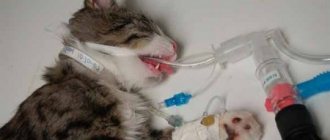Castration - This is an artificial cessation of the function of the male gonads.
The question of whether to castrate or not to castrate your pet cat sooner or later arises for its owner as soon as your beloved creature reaches puberty.
Here are some reasons why you will constantly be faced with the question of the need to castrate your cat:
- Your home, once presentable and serving as your place of relaxation after a hard day, suddenly turns, with the help of your pet, due to the fact that he has properly “marked his territory,” instead of relaxation into the territory of nightmares. A persistent unpleasant odor spreading throughout the apartment creates additional difficulties for you with hygiene and sanitation.
- Behavioral reactions. As a result of the release of hormones into the bloodstream, the animal experiences a stressful state - the cat becomes restless, aggressive, begins to train its vocal cords, and at the same time gets on the nerves of not only the family, but also the neighbors in the stairwell. His appetite worsens, instead of using a tray, he begins to urinate in the corners of the room, rubs against furniture, etc.
- In search of a friend, she strives to break free, running away from her home, sometimes mating with a stray cat.
- The periodic release of sex hormones into the blood, without satisfying physiological needs, has a very harmful effect on the cat’s body. Your cat becomes more susceptible to certain infectious diseases common among animals in your city.
At what age should a cat be neutered?
Puberty in cats, depending on the breed, feeding and maintenance conditions, begins at 7-9 months of age.
Therefore, most veterinary specialists believe that cats by this age will be well strengthened and can easily tolerate anesthesia. And the absence by this age of sexual intercourse with a cat and the instinct to mark its territory will be a good guarantee for you that your castrated cat will subsequently behave adequately.
At the same time, veterinary specialists abroad tend to castrate cats earlier, at approximately 2-4 months. Foreign experts justify castration at such an early age by the fact that castration done at such an age does not in any way affect the further development of the cat. Breeders also strive to ensure that a cat not intended for breeding is castrated early.
Is it possible to castrate a cat at a later date, for example, at the age of 5-6 years?
Of course it is possible, only at this age the cat may have complications associated with anesthesia. In such cases, the veterinary clinic will offer you an in-depth examination of your pet, including a blood test, etc., due to the fact that at this age the cat may have certain pathological processes in the body.
Animal owners need to keep in mind that the earlier the operation (castration) is performed, the less likely there are certain operational risks. Additionally, you will prevent a large number of diseases associated with the cat’s sexual need.
General information
Castration is a procedure aimed at suppressing the sexual function of an animal. Not in all cases this requires surgical removal of the cat's testes.
There are several types of sterilization when a scalpel is not required (or is required, but for other purposes):
- Medication. In this case, a special cartridge is implanted under the pet’s skin, which gradually releases substances that suppress libido. One of the most popular and effective remedies is Suprelorin.
- Chemical _ Substances that suppress the growth and development of glandular tissue cells are injected directly into the testes. This type of sterilization is especially common in India, where a 10% calcium chloride solution is used for the procedure.
- Radiation. The testes are irradiated under a source of directed gamma radiation.
All three of these types are especially recommended by veterinarians to owners of older cats, since these methods are the least traumatic.
However, due to the low prevalence of some of them (chemical castration) and the high cost of others, surgical sterilization is still the most common. It is cheap, effective, and takes very little time. True, its implementation in the case of four-year-old cats and older is fraught with some difficulties.
How to properly prepare a cat for castration surgery?
The operation is performed only on clinically healthy animals. Your cat should not have any symptoms associated with the disease. The cat must be vaccinated against infectious diseases common in your city among its relatives. Therefore, if you have not been vaccinated against these diseases, you need to go to your veterinary clinic and, in agreement with your veterinarian, undergo the entire range of necessary vaccinations. Since surgery always leads to a decrease in the body’s resistance and, accordingly, immunity, there is a risk of a neutered cat contracting one or another infectious disease.
A few days before castration, you will need to treat your cat for helminthic diseases as a preventive measure.
Before carrying out a planned operation, especially on older cats, at the veterinary clinic, specialists will suggest that you undergo an ultrasound or ECG of the heart in order to prevent possible complications during the operation.
Before the operation itself, you need to keep your cat on a 12-hour fasting diet (drinking water is not limited).
Possible complications from anesthesia
Any operation has a certain degree of danger. This is not due to the surgical intervention itself, but to the effect of anesthesia, which is by no means harmless.
The consequences of general anesthesia can be as follows:
- Stopping breathing. During anesthesia, an animal's breathing slows down; usually the pet experiences this normally, since all body functions are inhibited. However, in case of an overdose, pulmonary activity can completely stop, and this is fraught with death. The problem is eliminated with the help of ventilation of the lungs and the supply of pure oxygen, and heparin is also administered intravenously.
- Heart problems . Arrhythmias, failure, tachycardia and other complications are possible. All this can lead to pulmonary edema, a drop in blood pressure, or even cardiac arrest. The pathology is eliminated with the introduction of beta-blockers; to control the pet’s condition, it is connected to an ECG machine.
- Drop in blood pressure and organ failure . It is observed in case of heart problems or an overdose of anesthesia. The sudden development of severe hypotension leads to failure of many systems and organs (kidneys, liver), since they need a certain level of pressure to function. The problem is eliminated with the help of an injection of polyglucin or ephedrine with dopamine.
- Anaphylactic shock . It manifests itself in the form of a sharp drop in blood pressure and pulmonary edema. Anaphylactic shock is possible with the introduction of any new drug, so anesthesia is no exception here. Shock is relieved with antiallergic drugs (prednisolone).
- Chills . Since the brain is responsible for temperature changes, the activity of which is inhibited during anesthesia, a violation of thermoregulation often becomes a side effect. Pathology rarely leads to any serious consequences. To warm your pet, you can inject magnesium sulfate intravenously or place the animal on a regular heating pad.
- Pulmonary edema . Appears with heart failure or an overdose of anesthesia. It often does not develop immediately, but after surgery, sometimes even on 2-3 days, when the pet is taken home. Manifests itself in the form of heavy breathing, cyanosis of the mucous membranes, sputum with foam. They are treated with pulmonary ventilation and sulfocamphocaine is administered intravenously.
- Brain swelling . Develops with an overdose of anesthesia or heart failure. Symptoms include a variety of neurological disorders: convulsions, paralysis, agitation, and impaired thermoregulation. The leading symptom is tension and contraction of the muscles of the back of the head, which causes the animal's head to fall back. Therapy consists of surgical reduction of intracranial pressure, as well as intravenous injection of glucocorticosteroids.
Where is the best place to castrate a cat?
Currently, you can castrate a cat either in a veterinary clinic or in your apartment, since such types of services are widely advertised by veterinary clinics and private practicing veterinarians. The rules for performing the operation in the clinic and at home remain the same and consist of removing the testes, preventing postoperative complications, reducing pain and ease of care for the cat on the part of the owner.
Castration of a cat at home has a number of advantages for the owner and the cat.
Your cat is in his usual room environment and therefore will not experience additional stress associated with a trip to the clinic and an unusual environment in a veterinary clinic. There is no risk of catching any cat infection (patients with sick cats go to the appointment).
Castration in a cat is a non-abdominal operation, which is why it does not require special sterile conditions in the operating clinic when it is necessary to perform sterilization in cats. The anesthesia is less deep and shorter.
Castration in a veterinary clinic, when you can, at your request, leave the cat in the hospital until the wounds heal (7-10 days) or take him with you immediately after castration. It also has its pros and cons.
Pros:
- You don't have to take your cat home right away, especially in the cold season.
- You do not have to independently provide post-operative care for the cat and carry out manipulations prescribed by a veterinarian (injections, giving pills, treating surgical wounds), especially if you do not have certain skills in this matter.
- You relieve yourself of responsibility for the postoperative procedures prescribed by the veterinarian and if any complications arise, then all claims against the veterinary clinic.
- Medical post-operative monitoring of your cat’s health, especially when he has certain health problems.
Minuses:
- Being in an unusual environment will cause your cat to experience additional stress.
- Upon returning home, especially if your cat is very touchy, it will take time for you and your cat to restore your previous friendly relationship.
- The possibility of getting a so-called “nosocomial” feline infection cannot be ruled out.
- Using a veterinary clinic will require significant financial expenses from you.
Character and temperament
Is it possible to castrate a cat at 5 years old if the only problem is his playfulness and mobility? No, in this case it is better to leave everything as is. It is a myth that after removal of the testes the animal becomes calm and sleepy. Just like people, cats have different personalities and temperaments. If your pet is active and playful by nature, then it will not become a sofa ottoman.
How is a cat castrated?
Castration of animals is one of the simplest surgical operations performed in veterinary surgery. Veterinary specialists usually perform the operation in an open manner. First, the cat is given general anesthesia, after which the veterinarian shaves the hair in the scrotum area. Then he performs aseptic treatment of the surgical field. During castration, the surgeon makes two longitudinal incisions in the skin of the scrotum, then removes one testis from the scrotum, with the spermatic cord and vessels, ties it with a ligature and removes the testis. Then the second testis is removed in the same sequence. At the end of the operation, antiseptic treatment of the resulting wound is performed. The surgical wound is usually not sutured by the surgeon, which facilitates the drainage of the resulting lymph and blood in the postoperative period. The operation to castrate a cat usually lasts 30-40 minutes, and given that it is performed under general anesthesia, it is painless for the cat. The veterinarian performing the castration is present until the cat fully recovers from anesthesia. After which the owner of the neutered cat will be given recommendations on caring for the cat in the postoperative period and subsequent diet.
Anatomical nuances
As you know, the testes are located in a small skin “pouch” located under the anus behind the cat’s penis. This “pouch” of skin is called the scrotum or scrotal pouch. It is from this that the veterinary surgeon will cut out the testes. The latter are connected to the abdominal cavity by vessels. They, together with the spermatic cords, enter the pelvic cavity through openings called the inguinal canals. After passing from the abdominal cavity through the inguinal canal, the vessels and ducts, together forming the cord, pass into the scrotal cavity.
Some of the thick connective tissue lining the animal's abdominal cavity also passes through the inguinal openings and lines the inside of the scrotal sac. Scientifically, this tissue is called the tunica vaginalis. Among other things, this structure releases a certain amount of fluid that performs a lubricating function. Thanks to this, the testicles can move inside the scrotal sac.
Postoperative care for a neutered cat at home
In cats after castration, stitches are not placed on the surgical wound. Such a wound, treated by a veterinarian with Terramycin or Alusprey, does not require additional care from you.
When recovering from a state of anesthesia, the cat still cannot control the urination reflex and in order to avoid this trouble it is necessary to put a diaper on it. The cat may have occasional bouts of vomiting.
Normally, a cat’s appetite after castration appears within the first 2 days. You need to start feeding your cat in small portions, in several doses. If your cat refuses food for more than 5 days after castration, then you need to contact a veterinary clinic. If the operation went well, appetite and thirst should be the same as before castration.
The amount of urine in the first days after castration, especially if the cat has no appetite, may be reduced. After the operation, the cat must stay at home for several days without going outside. In order to relieve post-operative stress, you should pay more attention to your cat and try to make sure that he does not rub his scrotum area on the floor. In order to eliminate swelling of the scrotal area caused by the operation, you can treat the scrotum with Levomekol or Nebacitin ointment.
You can find additional information about castration of a cat in the article on our website “Reality and myths about castration of pets.”
When surgery doesn't make sense
Quite often, by removing the testes, owners want to correct the behavior of their pet. But in this case we are talking about an adult animal with already formed behavioral habits. Therefore, when a veterinarian is asked whether it is possible to castrate a cat if he is 5 years old, he must explain to the owner that this is not a magical procedure that will make their pet calm, affectionate and flexible in one moment. It makes no sense to remove the testes if:
- The pet constantly asks to go outside. Here it’s not even about sexual activity, it’s just more interesting there than at home.
- The cat is aggressive. If this is due to the disposition and habits of the animal, then the operation will not help in any way.
- The animal has been pooping everywhere for a long time. After the operation, it will no longer leave marks that are needed to attract females. But such a procedure cannot accustom him to the tray. If a cat has chosen a place for the toilet, then it is usually very difficult to retrain it.











